Related Research Articles

The history of the graphical user interface, understood as the use of graphic icons and a pointing device to control a computer, covers a five-decade span of incremental refinements, built on some constant core principles. Several vendors have created their own windowing systems based on independent code, but with basic elements in common that define the WIMP "window, icon, menu and pointing device" paradigm.

Lotus 1-2-3 is a discontinued spreadsheet program from Lotus Software. It was the first killer application of the IBM PC, was hugely popular in the 1980s, and significantly contributed to the success of IBM PC-compatibles in the business market.

WordStar is a discontinued word processor application for microcomputers. It was published by MicroPro International and originally written for the CP/M-80 operating system, with later editions added for MS-DOS and other 16-bit PC OSes. Rob Barnaby was the sole author of the early versions of the program.

CP/M, originally standing for Control Program/Monitor and later Control Program for Microcomputers, is a mass-market operating system created in 1974 for Intel 8080/85-based microcomputers by Gary Kildall of Digital Research, Inc. CP/M is a disk operating system and its purpose is to organize files on a magnetic storage medium, and to load and run programs stored on a disk. Initially confined to single-tasking on 8-bit processors and no more than 64 kilobytes of memory, later versions of CP/M added multi-user variations and were migrated to 16-bit processors.
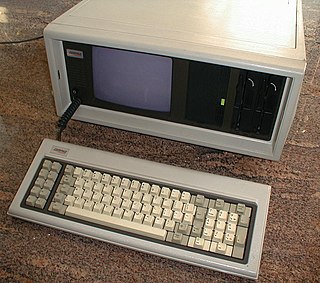
IBM PC–compatible computers are technically similar to the original IBM PC, XT, and AT, all from computer giant IBM, that are able to use the same software and expansion cards. Such computers were referred to as PC clones, IBM clones or IBM PC clones. The term "IBM PC compatible" is now a historical description only, since IBM no longer sells personal computers after it sold its personal computer division in 2005 to Chinese technology company Lenovo. The designation "PC", as used in much of personal computer history, has not meant "personal computer" generally, but rather an x86 computer capable of running the same software that a contemporary IBM PC could. The term was initially in contrast to the variety of home computer systems available in the early 1980s, such as the Apple II, TRS-80, and Commodore 64. Later, the term was primarily used in contrast to Apple's Macintosh computers.

Xenix was a version of the Unix operating system for various microcomputer platforms, licensed by Microsoft from AT&T Corporation in the late 1970s. The Santa Cruz Operation (SCO) later acquired exclusive rights to the software, and eventually replaced it with SCO UNIX.
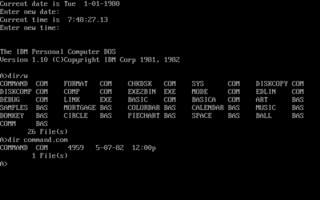
IBM PC DOS, also known as PC DOS or IBM DOS, is a discontinued disk operating system for the IBM Personal Computer, its successors, and IBM PC compatibles. It was manufactured and sold by IBM from the early 1980s into the 2000s. Developed by Microsoft, it was also sold by that company as MS-DOS. Both operating systems were identical or almost identical until 1993, when IBM began selling PC DOS 6.1 with new features. The collective shorthand for PC DOS and MS-DOS was DOS, which is also the generic term for disk operating system, and is shared with dozens of disk operating systems called DOS.

Microsoft Works is a discontinued productivity software suite developed by Microsoft and sold from 1987 to 2009. Its core functionality includes a word processor, a spreadsheet and a database management system. Later versions have a calendar application and a dictionary while older releases include a terminal emulator. Works is available as a standalone program and as part of a namesake home productivity suite. Because of its low cost, companies frequently preinstalled Works on their low-cost machines. Works is smaller, less expensive, and has fewer features than contemporary major office suites such as Microsoft Office.
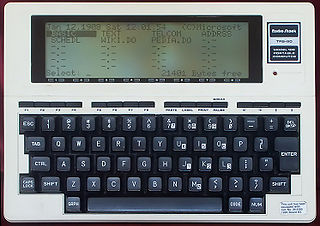
The TRS-80 Model 100 is a notebook-sized portable computer introduced in April 1983. It was the first commercially successful notebook computer, as well as one of the first notebook computers ever released. It features a keyboard and liquid-crystal display, in a battery-powered package roughly the size and shape of a notepad or large book. The 224-page, spiral-bound User Manual is nearly the same size as the computer itself.

Javelin Software Corporation (1984–1988) was a company in Cambridge, Massachusetts, USA, which developed an innovative modeling and data analysis product, also called Javelin, and later Javelin Plus. Seen as the successor technology to spreadsheet software in reviews of the time, and rival to the then-dominant Lotus 1-2-3, Javelin won numerous industry awards, including beating Microsoft's new Excel for the InfoWorld Software Product of the Year award.
FlexOS is a discontinued modular real-time multiuser multitasking operating system (RTOS) designed for computer-integrated manufacturing, laboratory, retail and financial markets. Developed by Digital Research's Flexible Automation Business Unit in Monterey, California, in 1985.
This article presents a timeline of events in the history of 16-bit x86 DOS-family disk operating systems from 1980 to present. Non-x86 operating systems named "DOS" are not part of the scope of this timeline.
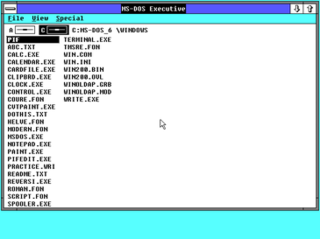
Windows 2.0 is a major release of Microsoft Windows, a family of graphical operating systems for personal computers developed by Microsoft. It was released to manufacturing on December 9, 1987, as a successor to Windows 1.0.

Windows 3.0 is the third major release of Microsoft Windows, launched in 1990. Its new graphical user interface (GUI) represents applications as clickable icons, instead of the list of file names in its predecessors. Later updates expand capabilities, such as multimedia support for sound recording and playback, and support for CD-ROMs.

MS-DOS is an operating system for x86-based personal computers mostly developed by Microsoft. Collectively, MS-DOS, its rebranding as IBM PC DOS, and a few operating systems attempting to be compatible with MS-DOS, are sometimes referred to as "DOS". MS-DOS was the main operating system for IBM PC compatibles during the 1980s, from which point it was gradually superseded by operating systems offering a graphical user interface (GUI), in various generations of the graphical Microsoft Windows operating system.
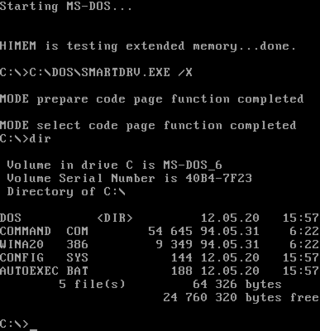
DOS is a family of disk-based operating systems for IBM PC compatible computers. The DOS family primarily consists of IBM PC DOS and a rebranded version, Microsoft's MS-DOS, both of which were introduced in 1981. Later compatible systems from other manufacturers include DR-DOS (1988), ROM-DOS (1989), PTS-DOS (1993), and FreeDOS (1998). MS-DOS dominated the IBM PC compatible market between 1981 and 1995.
Software Publishing Corporation (SPC) was a Mountain View, California-based manufacturer of business software, originally well known for its "pfs:" series of business software products, it was ultimately best known for its pioneering Harvard Graphics business and presentation graphics program.
DacEasy, Inc., originally Dac Software, Inc., was an American developer and publisher of productivity and accounting software active from 1985 to 2000 and based in Dallas, Texas. They were best known for their namesake DacEasy suite of accounting software for the IBM Personal Computer and IBM PC compatibles. The DacEasy software was launched in April 1985 as the least expensive integrated accounting software package on the market, at under US$50. At the time, all others on the market were at least several hundred US dollars per module.
References
- 1 2 "Lucid 3-D". InfoWorld. February 1, 1988. p. 44.
Lucid 3D comes with a reference manual in the form of ... Lucid 3D can display up to nine overlapping spreadsheet windows
- ↑ "Lucid 3-D 2.x". WinWorld.
Lucid 3-D 2.x. Lucid 3-D, created by PCSG, Inc. and sold by DacEasy, Inc., is a spreadsheet program for MS-DOS
- ↑ "Lucid 3-D Professional Spreadsheet for Home And Office".
REVIEW: Lucid 3-D for Windows is easy to learn, takes full advantage of Windows, designed to make 3-D charts look good, and features over 50 templates.
- ↑ "Lucid announces Windows version of spreadsheet". NLA.gov.au.
- ↑ "About the Ezian Company".
In 1983, Redman was the founder of PCSG, later named Lucid Corporation, ...
- ↑ "LUCID CONFERENCE - MODEL 100 SIG August 3,1986".
Redman and Michael Stanford Co-founders of Portable Computer Support Group .. (PCSG)
- ↑ "Lucid's History".
... they incorporated as PCSG corporation (Portable Computer Support Group).
- ↑ Bryan, Marvin (February 6, 1989). "Multidimensional concept gains momentum". PC Week. 6 (5). Ziff-Davis: 106 et seq. – via Gale.
- ↑ "Lucid 3-D VERSION 1.22". InfoWorld . January 16, 1989.
Lucid 3-D is the only major memory- resident spreadsheet available for the PC. The product was originally developed in 1984 as ...
- ↑ italicized is the heading of pages 2 & 3 of a four page ad published September 1988.
- ↑ PC Magazine, September 29, 1987 page 29
- ↑ "Open LCW files - File extension LCW".
.lcw - Lucid 3-D Spreadsheet. LCW file is a Lucid 3-D Spreadsheet. Lucid 3-D is a low cost spreadsheet program with several unique features